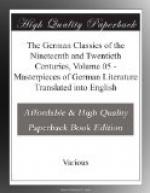The brothers Jacob and Wilhelm Grimm are the products of Romantic scholarship; they represent the highest type of scholarly attainment and of scholarly personality. They are always thought of together, for they shared all possessions alike and were not drawn apart by the fact that William married and Jacob remained a bachelor. Their fidelity to each other is touching, and no more lovable story is told than that of Jacob’s breaking down in a lecture and crying, “My brother is so sick!”
Jacob (1785-1863) was the philologist, the inductive gatherer of scientific material, the close logical deducer of facts. He “presented Germany with its mythology, with its history of legal antiquities, with its grammar and its history of language.” He is the author of Grimm’s law of consonant permutation which laid the foundations of modern philological science and is the founder of philological science in general.
Wilhelm (1786-1859), no less exact a scientist, was more a Romantic nature, with a greater power of synthesis under poetic stress. The two brothers began their collecting activities under the influence of Arnim, and their work with folk-tales in prose corresponds to The Boy’s Magic Horn in verse. It was Wilhelm who gave Grimms’ Fairy Tales their artistic form. He remolded, joined, separated—in fact, wrought the crude materials into such shape that this work has penetrated into every land and has become a household word for young and old. The various early editions show the progress in the method of Wilhelm. The first edition (1812) reproduces more exactly what the brothers heard; the later ones show that Wilhelm consciously attempted to give artistic form to the tales. That his method was justified the history of the stories proves; they are not only material for ethnological study, but are dear to all hearts. The stories have the genuine folk-tone; they are true products of the folk-imagination, with all the logic of that imagination. All phases of life are touched and the interest never flags. The spirit of nature has been kept.




